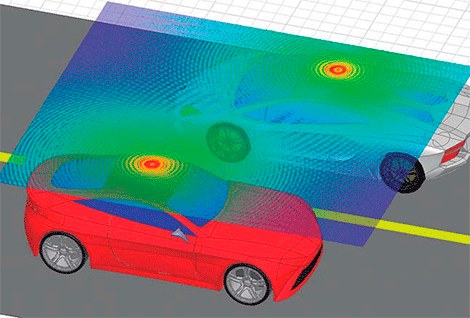No industry has advanced as far as the automotive industry. Companies in this sector have used simulation like no other sector has done to go beyond the limits of design, to persuade and fulfill the promises of innovation made to an increasingly demanding user.
The car of the XNUMXst century must be eco-efficient and robust, technologically intelligent and affordable, as well as fast and flawless in production. It must comply with increasingly stringent government regulations, and it must incorporate fast-evolving communication technologies and software that were virtually non-existent a few years ago. The success of the innovation of the companies in the automotive industry has gone through the rapid adaptation of simulation for engineering, which has allowed them to meet the demands of users and authorities, as well as achieve their own challenges and objectives. business in terms of cost-effectiveness.
How does simulation help to maintain the state-of-the-art character of the automotive industry? The challenges
Ansys, reveals what are the challenges of automotive companies and the car of the future:
Eco-efficiency
The government restrictions established worldwide are increasingly harsh and reaching the objectives implies the redesign of the cars to solve many challenges, such as the reduction of the aerodynamic resistance without sacrificing the cooling and the tranquility of the cabin, or reducing the weight of the vehicle while maintaining the specific needs of strength and resistance.
Complexity and cutting-edge technology, towards the autonomous car
Cars have gone from being mechanical machines to complex electronic machines.
Currently, seven automotive companies have announced their plans to sell or promote some form of autonomous or driverless car, including Google.
Through simulation, engineers can model the entire vehicle as a single system. In addition, it allows collaborative simulation, since it is consolidated as a unique platform in which the hundreds of engineers from the same company, employed in different countries to design different aspects of the vehicle, work together, thus improving opportunities for innovation and optimization. .
The “electronics of things”
Today's user demands intelligent interfaces attached to vehicles: satellite radio, GPS units, touch screens integrated into dashboards or headrests. Manufacturers are currently offering, for example, 4G LTE Wi-Fi (along with the antennas that make it possible). Components such as the keys or the window and door locks are activated through software, as are the consumption, mileage and emissions indicators. The software controls the rear view cameras, the batteries, the acceleration and braking systems... Today's car is a computer on wheels. The functionalities of the Internet of Things have required and require high-fidelity simulation tools.
At the top of the trends: in-silico tests
Electronics advances and the interaction of physics increases. In an engine, for example, the electronic, magnetic, thermal, fluid, structural and acoustic aspects are totally related: the flow of refrigeration affects the temperature; temperature affects electromagnetic fields; these affect the efficiency of the engine and structural vibrations, which are transformed into noise. In this sense, in-silico tests (on a computer) relegate to in-vivo tests, which will be carried out only when the predictions of the product's behavior really reach perfection.
In this way, companies achieve design optimization after simulating and observing the behavior of the vehicle, of each of its components as part of a larger system, in all types of external conditions and real scenarios. And what's more, it's achieved faster and more cost-effectively, allowing you to get the most out of your investment in innovation.
Although simulation is not something new in the automotive world, the implementation of common business simulation platforms has become a crucial element in the strategy of the most cutting-edge companies, since it allows them to keep up with the pace of development in the face of needs innovation at all technical levels.
The car of the XNUMXst century must be eco-efficient and robust, technologically intelligent and affordable, as well as fast and flawless in production. It must comply with increasingly stringent government regulations, and it must incorporate fast-evolving communication technologies and software that were virtually non-existent a few years ago. The success of the innovation of the companies in the automotive industry has gone through the rapid adaptation of simulation for engineering, which has allowed them to meet the demands of users and authorities, as well as achieve their own challenges and objectives. business in terms of cost-effectiveness.
How does simulation help to maintain the state-of-the-art character of the automotive industry? The challenges
Ansys, reveals what are the challenges of automotive companies and the car of the future:
Eco-efficiency
The government restrictions established worldwide are increasingly harsh and reaching the objectives implies the redesign of the cars to solve many challenges, such as the reduction of the aerodynamic resistance without sacrificing the cooling and the tranquility of the cabin, or reducing the weight of the vehicle while maintaining the specific needs of strength and resistance.
Complexity and cutting-edge technology, towards the autonomous car
Cars have gone from being mechanical machines to complex electronic machines.
Currently, seven automotive companies have announced their plans to sell or promote some form of autonomous or driverless car, including Google.
Through simulation, engineers can model the entire vehicle as a single system. In addition, it allows collaborative simulation, since it is consolidated as a unique platform in which the hundreds of engineers from the same company, employed in different countries to design different aspects of the vehicle, work together, thus improving opportunities for innovation and optimization. .
The “electronics of things”
Today's user demands intelligent interfaces attached to vehicles: satellite radio, GPS units, touch screens integrated into dashboards or headrests. Manufacturers are currently offering, for example, 4G LTE Wi-Fi (along with the antennas that make it possible). Components such as the keys or the window and door locks are activated through software, as are the consumption, mileage and emissions indicators. The software controls the rear view cameras, the batteries, the acceleration and braking systems... Today's car is a computer on wheels. The functionalities of the Internet of Things have required and require high-fidelity simulation tools.
At the top of the trends: in-silico tests
Electronics advances and the interaction of physics increases. In an engine, for example, the electronic, magnetic, thermal, fluid, structural and acoustic aspects are totally related: the flow of refrigeration affects the temperature; temperature affects electromagnetic fields; these affect the efficiency of the engine and structural vibrations, which are transformed into noise. In this sense, in-silico tests (on a computer) relegate to in-vivo tests, which will be carried out only when the predictions of the product's behavior really reach perfection.
In this way, companies achieve design optimization after simulating and observing the behavior of the vehicle, of each of its components as part of a larger system, in all types of external conditions and real scenarios. And what's more, it's achieved faster and more cost-effectively, allowing you to get the most out of your investment in innovation.
Although simulation is not something new in the automotive world, the implementation of common business simulation platforms has become a crucial element in the strategy of the most cutting-edge companies, since it allows them to keep up with the pace of development in the face of needs innovation at all technical levels.








